10 Swaps That Slash Your Sugar Intake
It's possible to cut back without feeling like you're being punished.
By Emma Haak
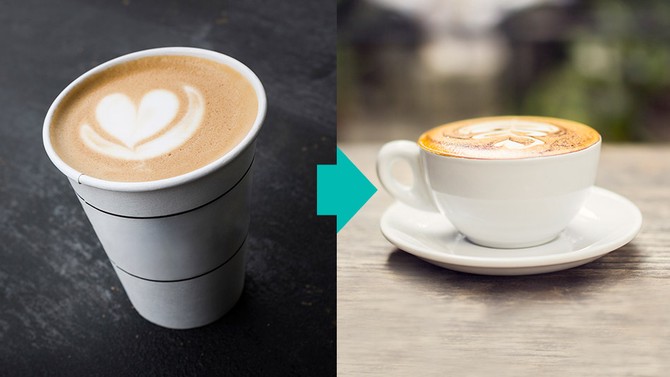
Photo: Spiderstock, amnarj2006/istockphoto
At Breakfast
Aside from skipping the pastries and baked goods (admit it–muffins are just cupcakes without the frosting), reducing your a.m. sugar intake is all about beverages.
Toss: Your regular vanilla latte. A grande size from Starbucks has 35 grams of sugar.
Have This Instead: A cappuccino. A grande cappuccino at Starbucks has 10 grams of sugar.
Sugar Saved: 25 grams, roughly the amount in a kid-size fast food milkshake. If you're more of an at-home or office-coffee-machine type, but you always add a packet or two of sugar, try replacing the sugar with a pinch of cinnamon, or swap both milk and sugar for coconut milk, which is naturally sweet, says McKel Hill, RDN, the author of Nutrition Stripped.
Toss: A glass of OJ, which has about 21 grams of sugar.
Have This Instead: You could eat the actual fruit (we know...you've heard that advice 1,000 times), or you could follow this suggestion from Stefanie Sacks, a certified dietician, culinary nutritionist and the author of What the Fork Are You Eating?: water down your juice with sparkling water or seltzer. Start with 1/2 juice, 1/2 water and work your way down to 1/4 juice, 3/4 water.
Sugar Saved: Around 15 grams, once you reach that 1/4-juice mark. That's about the amount in half of a chocolate candy bar.
Toss: The sweetened-nut milks you add to your morning smoothie. Sweetened vanilla almond milk has 15 grams of sugar per 8-ounce serving.
Have This Instead: Go for unsweetened milks (they can still be flavored). As long as it's unsweetened, it'll have no sugar.
Sugar Saved: If you're downing a smoothie with 4 ounces of sweetened almond milk on the way out the door every morning, you're drinking 225 grams of sugar per month, about the amount in 5 1/2 cans of cola.
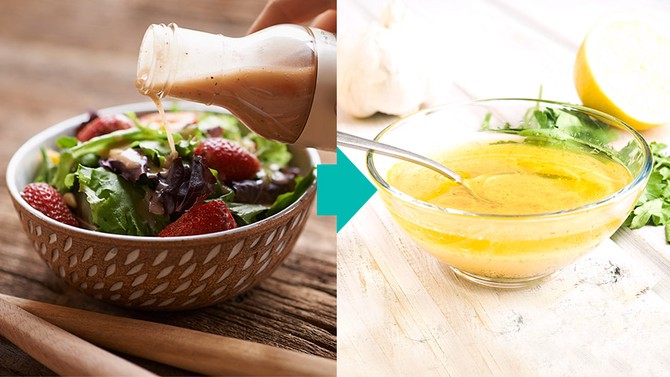
Photo: jeffbergen, Jultud/istockphoto
At Lunch
If you're already doing the smart thing by brown-bagging it, these swaps can make a big difference.
Toss: Bottled salad dressing. Here's how much sugar you'll find in 2 tablespoons of some popular varieties (and we know you're probably using more than 2 tablespoons): French, 5.1 grams; Italian, 3.16 grams; Russian, 7 grams; Balsamic Vinaigrette, 4 grams; Honey Mustard; 7 grams; Raspberry Vinaigrette; 5 grams.
Have This Instead: Make your own. Salad dressings are easy to whip up, and often cheaper than store-bought ones. We've got 5 delicious yet simple recipes.
Sugar Saved: Depending on the DIY recipe you use, you could make a salad dressing with no sugar. If you used to use 2 tablespoons of Russian dressing on your lunch salad Monday through Friday, that's 35 grams of sugar per workweek, gone. (Equivalent to 4 fun-size chocolate candies.)
Toss: The reduced-fat peanut butter on your sandwich, which can pack 4 grams of sugar in 2 tablespoons. (Reduced-fat anything normally has higher sugar amounts, says Hill, because companies replace the fat with sugar to keep the product from tasting bland.)
Have This Instead: Go for full-fat varieties, which often have around 1 gram of sugar per 2 tablespoons. You can take it one step further and find no-sugar-added options, which, you guessed it, have no sugar.
Sugar Saved: If you're dining on PB&J three times a week, that's 12 grams of sugar you're no longer eating, about the amount in 2 soft store-bought chocolate-chip cookies.
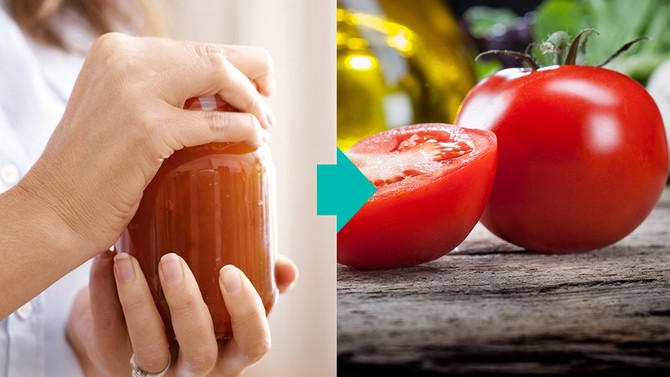
Photo: StA-gur Karlsson, ollo/istockphoto
At Dinner
Sugar hides in 2 common supper staples.
Toss: Store-bought marinara or pasta sauce. Just a 1/2 cup can have almost 6.5 grams of the sweet stuff.
Have This Instead: Either make your own (here are 6 quick and easy ideas) or scan the pasta aisle for no-sugar-added options.
Sugar Saved: If you're having pasta once a week and using 1/2 cup of sauce each time, you'll save yourself 338 grams of sugar each year. That's a little more than the amount you'd consume if you ate an entire 16-ounce tub of creamy vanilla frosting.
Toss: The ketchup you add to your burger or hot dog or dunk your fries in. One tablespoon packs 4 grams of sugar.
Have This Instead: Buy low-sugar ketchups, which usually have around 1 gram of sugar per tablespoon. You can also make your own–the simplest recipes take about an hour, but you can make a big batch and have it on hand for next time.
Sugar Saved: Burgers, dogs and fries are probably not a staple of your dinner rotation, but if you have them here and there throughout the year and replace regular ketchup with a low-sugar version, you'll save 6 grams of sugar for every 2-tablespoon serving. If you indulge this kind of meal once every two months, that's 36 gram of sugar out of your diet (the same amount you'd find in 1 1/2 bakery-made brownies.)
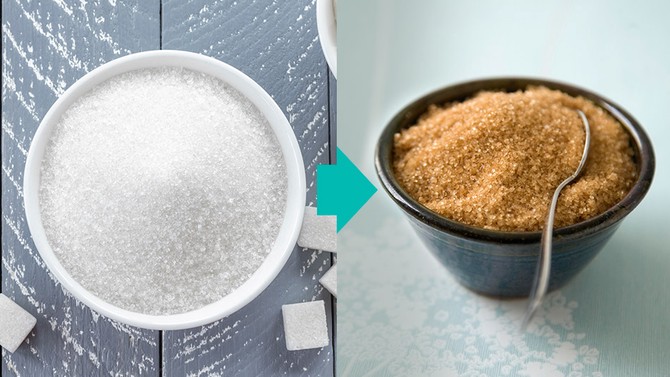
Photo: YelenaYemchuk/istockphoto, Joy Skipper/Getty Images
Dessert-Time
Using this alternative sweetener in your home baking makes it possible to cut down on sugar while still satisfying your sweet tooth. Because no one is really satisfied with a square of dark chocolate for dessert (no one!).
Toss: Refined sugar
Use This Instead: Sucanat, or unrefined cane sugar. It's sweeter than regular sugar, with a strong molasses flavor, so a little can go a long way, meaning you use less sugar overall, says Jack Bishop, Chief Creative Officer for America's Test Kitchen, who oversaw the making of ATK's new cookbook, Naturally Sweet: Bake All Of Your Favorite's With 30% to 50% Less Sugar. Using Sucanat instead of regular sugar in their chocolate-chip cookies took the sugar content from 25 grams of sugar per cookie to 15 grams.
Important Tips: If you're swapping refined sugar for any alternative sweetener, you may need to adjust some other ingredients as well. A few cookie-specific discoveries Bishop and his team made during their baking research:
- Use melted butter instead of creamed butter: "Sugar holds onto moisture, which helps make for a chewier cookie," says Bishop. "Without it, you get a cakey cookie. But by melting the butter, you make the make the water in the butter more available to the flour, which gives you chew."
- Scale down your fats: If you cut back on sugar without adjusting your butter, you'll get greasy cookies, because sugar holds onto fats, says Bishop.
- Add extra baking powder or soda: More leavener will help the cookie spread out more, so you don't get a thick, cakey cookie. (Sugar normally helps with the spread.)
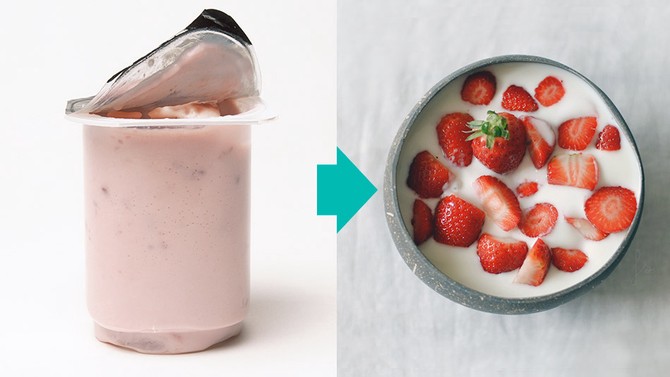
Photo:Andy Crawford,Fleur Schinning Photography/Getty Images
Snacks
Added bonus: These lower-sugar picks won't lead to a 4 o'clock crash.
Toss: Flavored yogurt, especially the low-fat kind (remember what we said earlier about low- or reduced-fat anything?). One container of low-fat vanilla yogurt has a whopping 23.5 grams of sugar.
Have This Instead: Plain Greek yogurt with real fruit mixed in. A 5.3-ounce container of whole-milk plain Greek yogurt has just 4 grams of sugar.
Sugar Saved: Almost 20 grams, which is about the same amount of sugar that's in 2/3 cup of chocolate ice cream.
Toss: Store-bought granola or trail mixes that are filled with chocolate chips, yogurt-covered nuts and sweetened dried fruit. It's hard to say exactly how much sugar is in these products because it depends on exactly what's in the mix, but Sacks says the amounts can be shockingly high for a seemingly healthy snack. (A half-cup of one brand's peanut butter and dark chocolate granola has 15 grams of sugar.)
Have This Instead: Make your own on-the-go snack, so you can control exactly how much sugar goes into it. Here are 6 kinds of granola you can whip up–play around with the sweetener amounts (these include honey, maple syrup and more) until you find the lowest amount that still tastes good to you.
Sugar Saved: If granola or trail mix is a daily thing for you, you'll be cutting out a significant amount of sugar.
Published 09/02/2016

